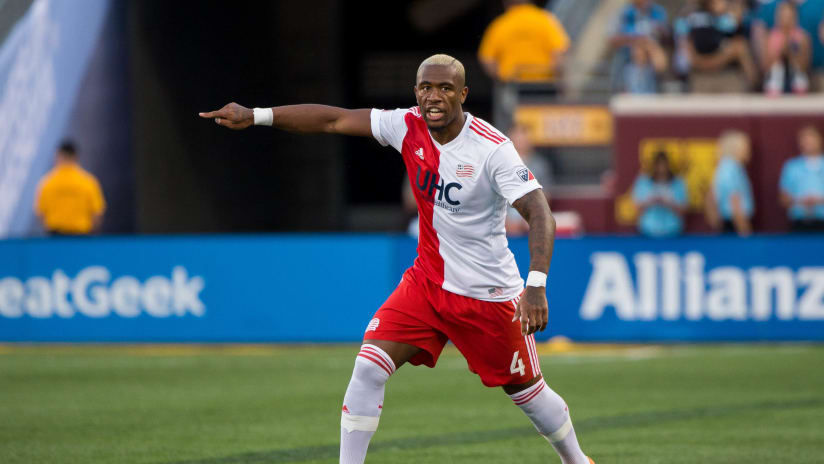See last week’s announcement, and you get one impression about the Portland Timbers’ center back depth chart. Liam Ridgewell and the club, mutually parting ways. Julio Cascante, Larrys Mabiala and Bill Tuiloma, still on the roster. Modou Jadama also there, ready to move up after a season with Timbers 2. Ridgewell’s was always going to be a major loss, but in the talent that was left, Portland has both present and potential in its center back corps.
The organization’s latest acquisition, though, tells a different story. Claude Dielna isn’t a long-term play – somebody who would slot in near Jadama on the depth chart and grow into the club. He is 31 years old. He not only has spent two seasons in MLS, having joined the New England Revolution in 2017, but contracts with clubs like Lorient, Olympiacos and Sheffield Wednesday highlight his resume. His acquisition requires the team spend some of its Targeted Allocation Money. This isn’t somebody that’s being brought in as a reinforcement. This is a player who’ll be expected to play, now.
As with most things, though, the truth between those two pictures lies in the middle, and thankfully, the reality becomes much clearer when you look back on President of Soccer Gavin Wilkinson’s season-ending words. In the days after MLS Cup, when he, technical director Ned Grabavoy and head coach Giovanni Savarese took the year’s final questions from the media, Wilkinson made clear the Timbers’ intentions regarding their roster.
“We’ll look to add three to four starting-caliber players that add competition for players,” Wilkinson said, when asked to clarify the team’s offseason plans.
Dielna fits perfectly into that plan. Is he guaranteed to slot into the starting XI, next to Mabiala, and pick up where Ridgewell left off? No. That would be too short-sighted about the potential of players like Cascante, Jadama and Tuiloma. Cascante profiles, physically, as a potential top defender in MLS. Tuiloma’s all-around skillset, in addition to how he stepped up in the 2018 playoffs, cast him as a great complement for either a Mabiala or a Cascante. Jadama has shown that the next stage of his growth needs to happen above the USL. All three of those players remain promising options, regardless of who’s added to the Timbers’ roster.
But gone are the days of the Timbers being locked into singular options, a theme Wilkinson talked about last offseason as Portland began using the resources obtained after Darlington Nagbe’s departure. Did the squad need to bring in a player, given Cascante, Mabiala and Tuiloma’s presence on the roster? No. Players like Cristhian Paredes and Samuel Armenteros, last winter, didn’t fill needs any more than the team needs players throughout the depth chart who will compete for time. But after the success Portland had in 2015, when players like Dairon Asprilla, Jack Jewsbury and Maxi Urruti proved so valuable, at the end, beyond the starting XI, a new standard has been pursued.
“[In 2017], we had Darren Mattocks,” Wilkinson explained about the backup strikers’ role last year, after Armenteros’ acquisition, expounding on the teams’ roster philosophies. “The objective, once we traded Darren, was to find a player that is in line with what we wanted and is good enough to play – good enough to start ...”
Insert Dielna into that view. The Revolution went through a transition, last season, with first-year head coach Brad Friedel intent on establishing a new culture. Dielna ended up fighting for time in the middle of a defense that also had Jalil Anibaba, Antonio Delamea and, in time, Michael Mancienne at center back. Ultimately, Dielna ended up splitting time between center and left back, but among New England’s broader defender corps, Dielna ended up leading the team in clearances per 90 minutes (4.5), as well as duels (10.9) and passes (45.6).
Picking out defensive stats and implying they, in isolation, have value can be disingenuous. Nobody should ever say, “Look at this guy’s clearance rate! What a player!” But compared to those asked to do similar things, last season – and do them under similar circumstances – Dielna had some positive indicators. And in those numbers, you see a type of all-around player who, between his physicality, quality on the ball, and versatility, could prove a good fit next to any potential partner on Portland’s roster.
Ultimately, though, this is move is less about what Dielna did in 2018 than what Wilkinson, Grabavoy and Savarese believe he can do in 2019. New England’s 55 goals conceded, last season, ranked 12th in the league, basically right in the middle of the MLS pack. Among teams that post those type of numbers, you usually find both positives and negatives within individual performances. Something about Dielna convinced Portland’s staff he was one of the positives.
That may just be a hunch. Whatever it was, it was something the team’s seen on film. Soon, though, that will change. When Dielna joins his new teammates, the theory of what he brings to Portland will have to become reality.
He’s being brought in to an MLS Cup contender to elevate the competition. The next step is his.












